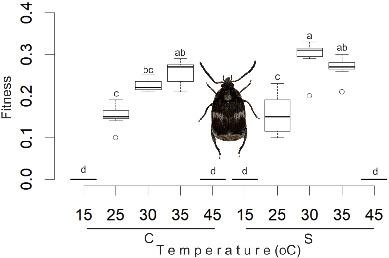当前位置:
X-MOL 学术
›
Physiol. Entomol.
›
论文详情
Our official English website, www.x-mol.net, welcomes your
feedback! (Note: you will need to create a separate account there.)
Life history trait response to ambient temperature and food availability variations in the bean weevil Zabrotes subfasciatus
Physiological Entomology ( IF 1.6 ) Pub Date : 2021-03-24 , DOI: 10.1111/phen.12358 Cindi P. Corrêa 1 , Sheila S. Parreiras 2 , Luiz A. Beijo 3 , Paulo M. Ávila 1 , Isabel R. V. Teixeira 1 , Angel Roberto Barchuk 2
Physiological Entomology ( IF 1.6 ) Pub Date : 2021-03-24 , DOI: 10.1111/phen.12358 Cindi P. Corrêa 1 , Sheila S. Parreiras 2 , Luiz A. Beijo 3 , Paulo M. Ávila 1 , Isabel R. V. Teixeira 1 , Angel Roberto Barchuk 2
Affiliation

|
Temperature is among the most influential factors in animal biology, and especially thermal fluctuations are key determinants of life history traits for ectothermic organisms. Diet characteristics add complexity to the effect of temperature on animals' life history traits. This is even more intricate in phytophagous insects that develop inside hosts. Here, using the seed beetle Zabrotes subfasciatus Boheman we tested life history trait response to five different ambient temperatures (15, 25, 30, 35, and 45 °C). We also tested the effect of the interaction between temperature and diet on the weevils' life history traits and estimated fitness for individuals at different temperature and food supplementation conditions. We first showed that the relationship between temperature and egg size and number, and adult emergence is altered by sugar ingestion, mainly at 30 °C. Additionally, we showed that temperature and sugar ingestion have opposite effects on longevity, with this trait being heightened by sugar ingestion at 25 °C. Interestingly, except at 35 °C, egg size shows a response that opposes the temperature-size rule, which states increasing environmental temperature reduces insect's size. Finally, excluding the extreme temperatures, fitness patterns increased with temperature and the clearer effect of parental feeding on fitness was registered at 30 °C. Since 30 °C is the temperature at which our weevil populations are maintained in the laboratory, these results point to a possible long-term “acclimation effect” on the weevils' fitness. Thus, testing the effect of the temperature experienced by the original population on the experimental weevils' fitness might shed light on the biological explanation of the observed temperature vs diet interaction.
中文翻译:

豆象鼻虫Zabrotes subfasciatus的生活史特征对环境温度和食物可用性变化的反应
温度是动物生物学中最有影响力的因素之一,尤其是热波动是变温生物生活史特征的关键决定因素。饮食特征增加了温度对动物生活史特征的影响的复杂性。这在寄主内部发育的植食性昆虫中更为复杂。在这里,使用种子甲虫Zabrotes subfasciatusBoheman 我们测试了生活史特征对五种不同环境温度(15、25、30、35 和 45 °C)的反应。我们还测试了温度和饮食之间的相互作用对象鼻虫生活史特征的影响,并估计了不同温度和食物补充条件下个体的健康状况。我们首先证明了温度与鸡蛋大小和数量之间的关系,以及成虫的出现会因糖的摄入而改变,主要是在 30°C。此外,我们发现温度和糖摄入对寿命有相反的影响,25°C 的糖摄入会增强这种特性。有趣的是,除了在 35 °C 时,鸡蛋大小显示出与温度大小规则相反的反应,即增加环境温度会减小昆虫的大小。最后,排除极端温度,健康模式随温度增加而增加,父母喂养对健康的影响更明显,在 30 °C 时记录。由于 30 °C 是我们的象鼻虫种群在实验室中维持的温度,因此这些结果表明对象鼻虫的适应性可能存在长期的“适应效应”。因此,测试原始种群所经历的温度对实验象鼻虫适应性的影响可能会阐明观察到的温度与饮食相互作用的生物学解释。
更新日期:2021-03-24
中文翻译:

豆象鼻虫Zabrotes subfasciatus的生活史特征对环境温度和食物可用性变化的反应
温度是动物生物学中最有影响力的因素之一,尤其是热波动是变温生物生活史特征的关键决定因素。饮食特征增加了温度对动物生活史特征的影响的复杂性。这在寄主内部发育的植食性昆虫中更为复杂。在这里,使用种子甲虫Zabrotes subfasciatusBoheman 我们测试了生活史特征对五种不同环境温度(15、25、30、35 和 45 °C)的反应。我们还测试了温度和饮食之间的相互作用对象鼻虫生活史特征的影响,并估计了不同温度和食物补充条件下个体的健康状况。我们首先证明了温度与鸡蛋大小和数量之间的关系,以及成虫的出现会因糖的摄入而改变,主要是在 30°C。此外,我们发现温度和糖摄入对寿命有相反的影响,25°C 的糖摄入会增强这种特性。有趣的是,除了在 35 °C 时,鸡蛋大小显示出与温度大小规则相反的反应,即增加环境温度会减小昆虫的大小。最后,排除极端温度,健康模式随温度增加而增加,父母喂养对健康的影响更明显,在 30 °C 时记录。由于 30 °C 是我们的象鼻虫种群在实验室中维持的温度,因此这些结果表明对象鼻虫的适应性可能存在长期的“适应效应”。因此,测试原始种群所经历的温度对实验象鼻虫适应性的影响可能会阐明观察到的温度与饮食相互作用的生物学解释。











































 京公网安备 11010802027423号
京公网安备 11010802027423号